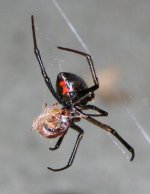8 Steps to Getting Rid of Spiders in your Home!
Most spiders love the outdoors but quite often they venture into your home searching for food and shelter. Here are 8 steps to take to get rid of those  unwanted pests:
unwanted pests:
- Seal up your home.
– Use caulk to fill in large gaps of space in closed doors and windows. Also apply caulk around wires, cables, faucets, and electrical components, since all of these must run to the outside.
– Replace or fix torn window screens. Spiders can easily find their way in through even the smallest holes. - Keep your outdoor lights off.
– On a similar note, block indoor lights from shining through your windows by using opaque blinds or shades.
– Consider switching to yellow sodium vapor lights. These are less appealing to insects and less likely to draw in a food source for your spiders. - Remove vegetation away from the perimeter of your house.
– Vegetation attracts spiders because it serves as an ample hiding spot. When spiders need to seek out warmth or new food sources, they crawl from the vegetation toward your home, getting in through cracks.
– You should also remove mulch, stones, leaves, or other debris near your home. - Keep a tidy house.
– Do not leave leftover food lying around. Food crumbs will attract other pests like ants, which, in turn, will attract spiders.
– Regularly sweep and vacuum your floors. Wipe down your counters and tables, and avoid letting your dirty dishes sit out for more than a few hours.
– Pick up as much clutter as possible. Old newspapers and piles of dirty clothes make the ideal hiding place for spider species that thrive in darkness.
– Use plastic storage containers. Airtight plastic containers are difficult for spiders to crawl into, but cardboard boxes are fairly easy. - Vacuum spiders and spider webs.
– This method works best when trying to get rid of a few spiders. It may not be very efficient if you have a large spider population living in your home, however.
– You can also use a broom to sweep away webs and squash adult spiders, but adult spiders are usually able to escape in between the bristles of the broom. This is especially true of small spider species.
– On a similar note, you can squash adult spiders and eggs with a shoe or other flat, hard object. The dead spider will need to be rinsed off in the sink or scraped off with a paper towel afterward. - Set out glue traps.
– Web-building spiders that spend most of their time along the ceiling are not likely to fall victim to the glue trap, but these are very effective against ground-dwelling spiders like jumping spiders and house spiders.
– Keep the trap flat to prevent it from curling up into itself.
– Discard the trap as soon as you collect a few spiders on it.
– Note that this is ineffective against spider eggs and webs, so you will likely need to use this method in conjunction with other techniques. - Apply a residual insecticide.
– Carefully follow the instructions marked on the label to prevent the accidental poisoning of yourself, a family member, or a pet.
– Pyrethroids are chemicals made, in large part, from pyrethrum plants. These plants are in the chrysanthemum family. Most household insecticides contain pyrethroids, and a few common pyrethroids include bifenthrin, cyfluthrin, permethrin, and tetramethrin.
– Total release foggers are not generally effective against spiders.
– Understand the limit of residual insecticides. These poisons only work if spiders drag themselves through the chemical after it is sprayed. – – If a spider manages to avoid the spray, the insecticide will have no effect on it. - Call a professional exterminator if all else fails.
– Be aware that most pest control companies offer two types of insecticides, the standard epa approved insecticides and the green/natural products.
To learn more about spiders in Virginia CLICK Here…..
For a FREE inspection and estimate CLICK Here….


































































